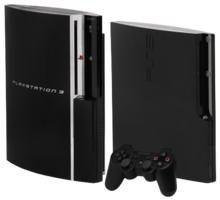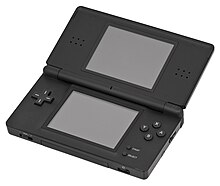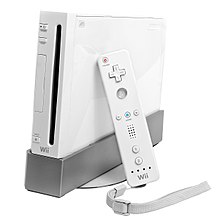Advanced Interactive Media/Media in Video Games
Multimedia is not only prevalent in cinema, television and the internet. Video game developers and producers are introducing new ways for people to interact with their games and game consoles. In the early years of video games, the most interactivity involved hitting a button and the onscreen character would react to the button's command. Today, however, media conglomerations, primarily Sony and Microsoft, are attempting new ways to bridge video games and other forms of media.
Microsoft Xbox 360
[edit | edit source]
Launched in the fourth quarter of 2005 around the world, the Xbox 360 is Microsoft's second foray into gaming hardware production. The console has expanded the internet media capabilities of Microsoft's original Xbox model.
Xbox Live
Launched in the summer of 2002 on the original Xbox, Xbox Live arguably set the standard for online console gaming. Players were able to create one profile for Xbox live. This profile, in turn, could interact with any Xbox Live equipped game.
Xbox Live Marketplace
In November 2005, Microsoft launched the Xbox Live Marketplace, an ancillary to their online gaming service. Through this, Xbox owners can download smaller arcade games, view previews of upcoming games and download demos for games still in development. Perhaps the most significant service provided in the Xbox Live Marketplace, however, is the Video Store, allowing gamers with an Xbox 360 to download movies and television shows directly to their computer. Though Microsoft is not the first company to offer downloadable content for television, they have arguably been the most successful and appear to be in a prime position to establish market domination. By bundling video downloads with games, it appears Microsoft is trying to create one central home theater peripheral by using games as the bridge. Microsoft's two biggest competitors in the gaming market, Nintendo and Sony, have both offered their own online services. Sony's, the PlayStation Network, currently offers many of the same online functions as the Xbox, while the Nintendo is currently limited to gaming information. The 2008 Consumer Electronics Show has released new features from Sony that will be a new point of interactivity for gamers.
Xbox & Windows Media Center
Xbox is breaking the mold by becoming the first game console to allow you to connect your pc to your gaming system. Using the Windows Media Center Extender technology built into your Xbox 360, you can connect it to your PC through your home network and enjoy all of the digital entertainment stored on your PC on the big screen from the comfort of your couch. You can easily play you’re your favorite music, view photos as a slide show, watch DVDs, download movies, and even watch and record TV shows. Xbox transforms your TV room into a digital media room all with the touch a remote.
Playstation 3
[edit | edit source]
The PlayStation 3 is Sony's fourth home market console.
Sony's Home
Still in prototype form, Home is a giant, free, massively multiplayer online community similar to the PC game Second Life. Offered as a free application exclusive to the PlayStation 3, Home allows users to create an online avatar and roam around a virtual world created by Sony. These worlds can include your PS3 and other PS3's. You can create your own home with furniture, rooms and electronics. You can also visit your friend's homes inside their PS3. It appears Home also features an online mall features shops like JCPenney, GameStop, and American Eagle. This software is expected to be released sometime in 2008.
Folding @ Home
A neat and "educational" free software program for the PS3 is folding @ home. What this little bit of code does is simulate proteins folding. In a nutshell, folding is when a protein atom changes its form. Evolution is another way of describing the process. The software was created for the Stanford Institute to help study folding. They are taking the data from the PS3 owners and attempting to find cures for many diseases. A disease is formed when a protein folds incorrectly and they hope to simulate correct and incorrect folding to find out how diseases are formed and can be cured. This software is also offered free to PC users. However the PS3 can run the software approximately 20-30 times faster than a PC of the same era.
Playstation Portable
[edit | edit source]
The Sony PSP or PlayStation Portable was the only major handheld competition to the Nintendo DS system. The PSP boasts graphics slightly stronger than the PlayStation 2 home video game console. But the game play and graphics are not the focus of this article. The thing I want to address is the VOiP and output to televisions from the PSP. First of all, Sony and Skype set an agreement to work together to create a VOiP network for PSP and PC users. VOiP or Voice Over Internet Protocol allows Skype users to take advantage of a free software program that allows PC to PC calls. With the new PSP, VOiP PSP users can make calls from PSP to PSP or PSP to PC for free. The software is free and only requires a firmware update from Sony. The only thing people have to purchase is a headset, but this is subject to change. Sony might charge a small fee for the Skype software to download into the PSP, but so far, this is still speculative. As of January 2008, the Skype firmware should be released for free. To use the Skype program on your computer go to Skype.com and sign up for their services.
The second part of this article is the new ability for PSP slim owners to output UMD movies onto a television. The new PSP slim allows users to take their games, music and movies and play them on their personal TV at home. You have to purchase some component cables for around $20, depending on the location, but now people can play their games and movies, even on the road, on a full size TV. This is a nice function if you forget your DVD player or are in a hotel with nothing better to watch.
One of the newest games for the PSP takes cell-shaded art and music and melts them together to create Patapon. This game is a very basic game. You are in charge of a small tribe of funny looking people who have been oppressed by big bad guys and you are there to help them defeat their enemies. Where the meat of this game lies is within the gameplay. You pound out beats on the square, circle, triangle and X button to create a beat that the soldiers will respond to. Based on what beats you let out depends on their attacks and movement. This game doesn't require quick shooting and reloading skills. It just takes a good sense of rhythm and beats per measure, In a sense it is teaching non-musical people how to play a drum beat. It can be an underlying way of teaching people more about the science of music through games.
Nintendo DS
[edit | edit source]
The Nintendo DS was a hand-held console on the market featuring local wi-fi multiplayer and online gameplay. The Nintendo company has their own version of Xbox live called NFC. The NFC of Nintendo Wi-fi Connection is a free online video game community through Nintendo. The players have to use friend codes that are linked with either your Nintendo DS or Nintendo Wii. The games on the current market require players to have friend codes in order to communicate over headsets. All the online games allow online gameplay, but communication is limited only to friends. Future games will allow players to talk to complete strangers during an online match. The Nintendo Wii has no availability for players to talk to each other currently.
Random Nintendo DS Facts
1. The Nintendo President Satoru Iwata thought it a smart move to launch the DS system in the US a week before it was launched in Japan.
2. The primary cost of the system was relatively cheap considering the technology built in.
Nintendo Wii
[edit | edit source]
The Nintendo Wii has taken interactivity to a whole new level. Games for the Wii have stopped focusing on button mashing and forces players to be active. Games using swords, fists and weapons can be activated by waving the WiiMote. The WiiMote and Nunchuk have motion sensors inside the controller and can sense even the slightest change in balance of the controller. A new game coming out in 2008 called Wii Fit uses a "Balance Board" for the game. Players must use the board for Yoga positions, balance positions, dance steps and many other features. Wii Fit also uses the WiiMote and has the player jog in place to simulate a race. The length of the race can range from feet to miles, but the approximate calories lost and similar stats are taken throughout the game.
Another feature the Wii has is the ability to send and receive emails to and from the Wii console. People, not necessarily just gamers, can send a full email to a Wii console as long as the Wii is connected to the internet, and sending emails from the Wii is also possible. This is not a new feature for a mobile game console, but the Wii is the first to do it effectively and smoothly. One other small feature is that when Wii-mail is sent there is a very specific identifier on the email.
Random Wii Facts
1. The Wii calendar shows dates from the year 2000 to the year 2035.
2. The Wii photo channel supports JPGs up to 8192×8192
3. The effect of direct sunlight and different light sources can make the WiiMote operation less responsive.
4. Classic Nintendo controllers can be used on SOME virtual console games.